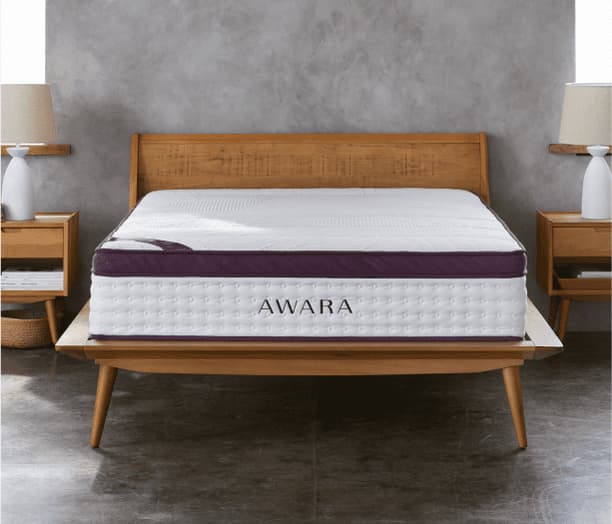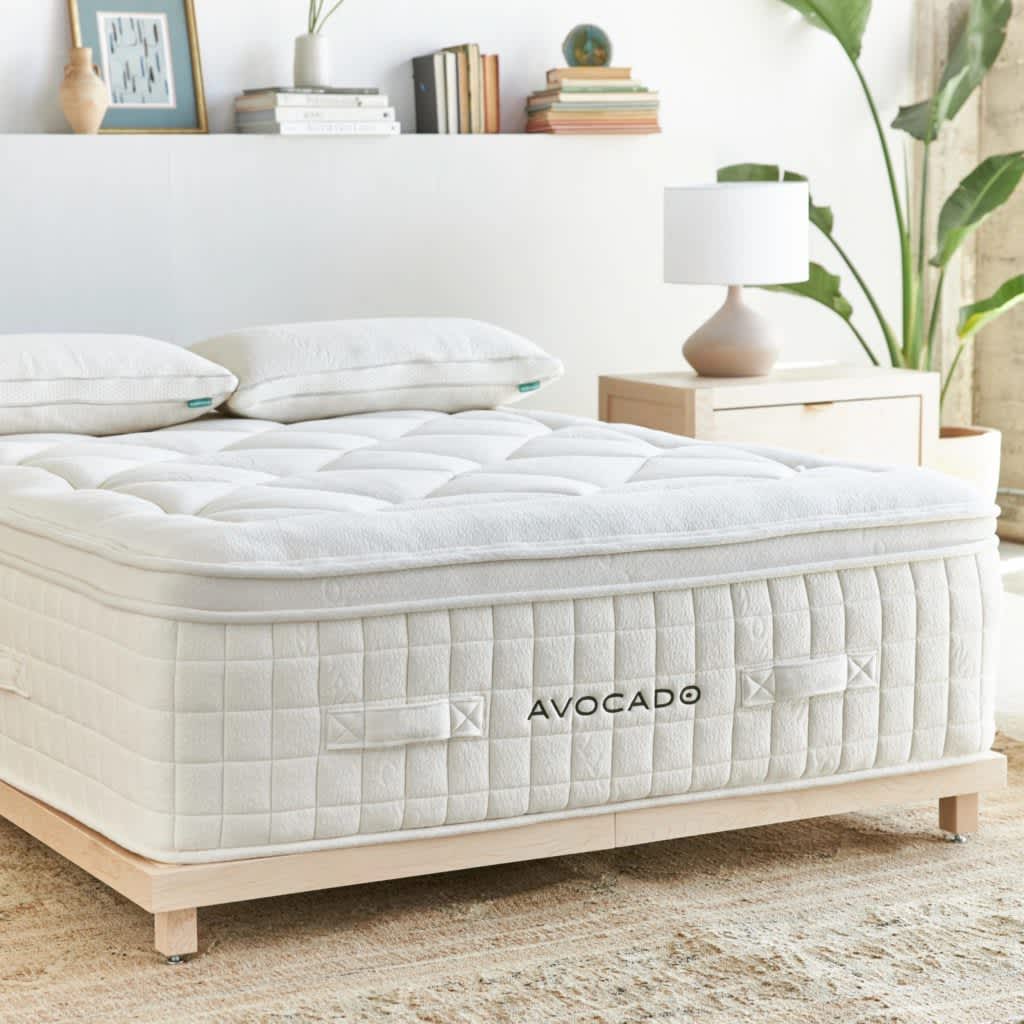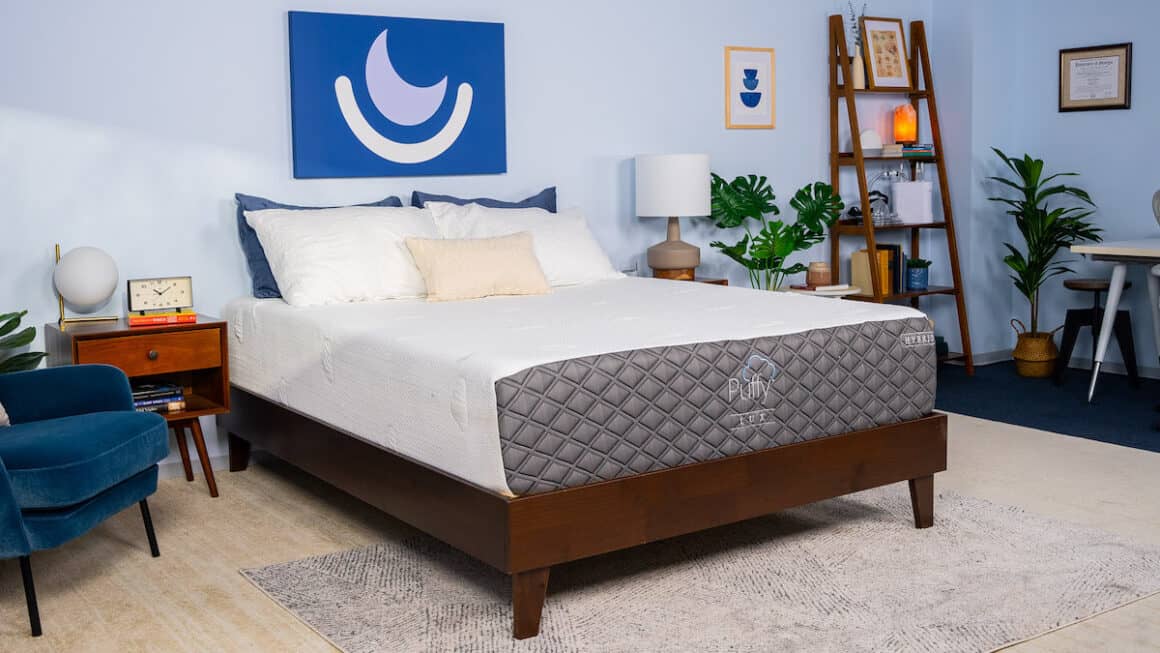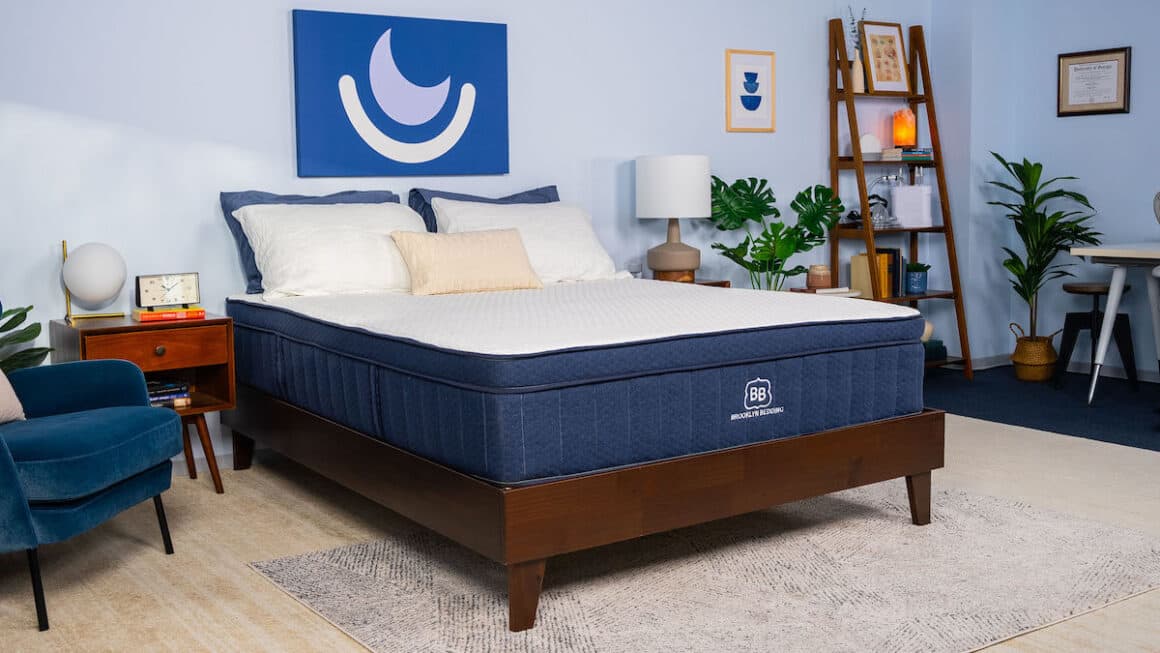On This Page
The Best Mattress for Menopause
Our Top Picks
-
Best Overall Mattress
Saatva Classic -
Best Value Mattress
Awara Natural Hybrid Mattress -
Most Comfortable Mattress
WinkBed -
Best Luxury Mattress
Avocado Organic Luxury Mattress -
Best Mattress for Back Pain
Puffy Lux Hybrid -
Best Cooling Mattress
Brooklyn Bedding Aurora Luxe
Best Overall Mattress
The Saatva Classic blends moderate contouring with targeted back support. The plush, quilted Euro-top cushions pressure points, while the memory foam lumbar pad reinforces good spinal alignment. Additionally, the coil support core and breathable cotton cover minimize heat buildup, making this mattress a great fit for those who want to alleviate menopause symptoms.
Pros & Cons
Pros
- Choice of three firmness levels and two mattress thicknesses
- Free White Glove delivery and old mattress removal
- Breathable, responsive construction with enhanced lumbar support
Cons
- Sleeping partner’s movements may travel across the bed
- Coils may produce some noise
- Returns have a $99 processing fee
Ratings
Our Take
Best Value Mattress

The Awara Natural Hybrid Mattress uses sustainably produced materials to create an exceptionally responsive bed that’s available at a comparatively reasonable price. The Dunlop latex evenly conforms to the body, improving spinal alignment and providing a balance of pressure relief and support for those with menopause symptoms.
Pros & Cons
Pros
- Organic cotton and wool, natural latex, and coils promote airflow
- Strong edge support makes getting in and out of bed easy
- Bouncy materials facilitate switching sleeping positions
Cons
- Firm feel may cause pressure points for side sleepers or those under 130 pounds
- Some motion may travel across the mattress from the coils
- Mattress profile is thin compared with other hybrids
Ratings
Our Take
Most Comfortable Mattress
The WinkBed comes in four firmness options to support a wide range of sleepers. The pressure relief provided by the quilted pillow-top and support foam will appeal to those who want a little extra cushioning, and the gel-infused polyfoam helps the mattress stay comfortably cool.
Pros & Cons
Pros
- Four firmness options, including one for sleepers over 250 pounds
- Zoned support with additional perimeter and lumbar reinforcement
- Gel-infused foam and pocketed coils that draw heat away from the body
Cons
- Firmer models may allow some movement to transfer across the bed
- Doesn’t offer the classic close contouring of memory foam
- Customized options may not work for both sleeping partners
Ratings
Our Take
Best Luxury Mattress

The Avocado Organic Luxury Mattress features organic, sustainably sourced materials that sleep cool. Its exceptionally thick comfort system cushions pressure points while preventing significant motion transfer, and the zoned pocketed coil core alleviates tension by spreading body weight evenly across the mattress.
Pros & Cons
Pros
- Made with breathable, all-natural materials
- Thick comfort section delivers pressure relief and reduces motion transfer
- Comes with year-long sleep trial and 25-year warranty
Cons
- Plush feel may not support stomach sleepers or those over 230 pounds
- Luxury price-point and fees for White Glove delivery and returns may exceed some budgets
- Thick mattress profile requires deep-pocket fitted sheets
Ratings
Our Take
Best Mattress for Back Pain

The Puffy Lux Hybrid is a great fit for sleepers in need of extra pressure relief, such as those with back pain related to menopause. Plush memory foam relieves tension, while two types of polyfoam promote neutral spinal alignment. The medium (5) firmness provides even contouring that works particularly well for side and back sleepers under 230 pounds.
Pros & Cons
Pros
- Thick foams cradle lumbar area while coil core supports spinal alignment
- Strong motion isolation and pressure relief promotes comfort
- Comes with free shipping to all 50 states, including Hawaii and Alaska
Cons
- Medium (5) firmness provides insufficient support for sleepers over 230 pounds
- Some heat retention can be expected
- Close-contouring foams inhibit movement and may compress along the edges
Ratings
Our Take
Best Cooling Mattress

The Brooklyn Bedding Aurora Luxe is a great fit for hot sleepers who like balanced contouring. Its adaptive comfort system evenly conforms to the body without retaining too much heat, which can be a big advantage for sleepers who experience hot flashes. The pocketed coil core and high-density foam base also provide above-average durability.
Pros & Cons
Pros
- Sold in medium soft (4), medium firm (6), and firm (7) options
- Phase-change material helps prevent heat buildup on mattress surface
- Pocketed coil core helps with air circulation
Cons
- Firm model may transfer some motion across surface
- May release off-gassing odors during the first few days
- Foam layers inhibit movement and lead to weaker edge support on soft option
Ratings
Our Take
Compare Our Top Picks
| Mattress | Mattress Type | Ideal For | Value | Sleep Trial |
| Saatva Classic | Innerspring | Back Sleepers | Fair Value | 365 Nights ($99 Return Fee) |
| Awara Natural Hybrid Mattress | Hybrid | Back Sleepers | Good Value | 365 nights (30-night requirement) |
| WinkBed | Innerspring | Side Sleepers | Good Value | 120 nights (30 night requirement) |
| Avocado Organic Luxury Mattress | Hybrid | Hot Sleepers | Fair Value | 365 nights (30-night break-in period) |
| Puffy Lux Hybrid | Hybrid | Couples | Good Value | 101 nights (14-night break-in period) |
| Brooklyn Bedding Aurora Luxe | Hybrid | Hot Sleepers | Good Value | 120 nights (30-night requirement) |
How Can a Mattress Help With Menopause?
Menopause brings about several changes that impact sleep, including a higher risk of developing sleep disorders such as sleep apnea and restless legs syndrome. While some menopause symptoms are unavoidable, the right mattress may help you sleep more comfortably.
- Hot flashes: A breathable mattress can help reduce discomfort from hot flashes, experienced by four in five people during menopause. Referred to as “night sweats” when they occur during sleep, hot flashes involve a sudden wave of heat that lasts for several minutes, sometimes accompanied by sweating and chills. Hot flashes often occur at night and may wake you up.
- Aches and pains: Finding a supportive mattress with strong pressure relief can help with aching or painful joints and breast pain, which are common during menopause. You can enhance pressure relief by adding a mattress topper to an existing mattress, but if your mattress is no longer capable of providing adequate spinal support, it’s time for a replacement.
- Balance problems: A mattress with reinforced edges can provide stability to facilitate getting in and out of bed if you live with menopause-related balance problems. When a mattress has weak edge support, sitting on the edge of the bed may lead to slipping.
Best Mattress Types for Menopause
Mattresses can be grouped into several categories depending on the materials used to make them. Knowing the mattress type can help you get an idea of how the mattress feels, as mattresses in the same category tend to share common attributes.
| Mattress Type | Pros | Cons |
| Hybrid |
|
|
| Latex |
|
|
| Foam |
|
|
| Innerspring |
|
|
| Airbed |
|
|
What to Look For in a Mattress for Menopause
Key attributes that many people value in a mattress for menopause include support, pressure relief, and temperature regulation. Additional factors to consider include your personal preferences and the sales terms and conditions.
Support
Most beds contain either steel coils or high-density foams to help keep the spine on an even plane. These sturdy materials prevent weight-bearing areas from sinking too far into the mattress, which could place stress on your back and exacerbate joint pain.
Your body type and sleeping position affect how you interact with the mattress. If you weigh more than 230 pounds or favor stomach sleeping, you need a firmer mattress to support the spine. If you weigh less than 130 pounds or prefer side sleeping, you might want a softer mattress that contours to relieve pressure points.
It’s common to gain weight during menopause, so you may find you need a firmer, more supportive mattress.
Comfort
Although support and pressure relief are considered the most important features of a mattress, other factors can also influence how comfortable the bed feels when a person is sleeping with menopause. It’s rare for a mattress to tick all the boxes, so you’ll have to prioritize the features that are most important to you.
If you often switch sleeping positions, you may want a mattress made with responsive latex or coils. If you sleep with a partner, a foam mattress can help cut down on noise and motion transfer so you don’t disturb each other’s sleep. A mattress with reinforced edges provides more usable surface area when you’re sleeping, as well as stability when getting in and out of bed.
Temperature Regulation
Mattresses with temperature-regulating technology can help reduce discomfort from hot flashes. Innerspring and hybrid mattresses have coil support cores that reduce heat buildup by allowing air to flow through the mattress. Mattresses made of natural materials such as wool, cotton, or latex also excel at maintaining a neutral temperature.
Foam mattresses leave less room for heat to escape, especially close-conforming models. To reduce heat buildup, these beds may use open-cell foams or aerated designs. Many foam mattresses also include copper, gel beads, or phase-change material designed to draw away heat.
Pressure Relief
Pressure relief may be especially important if you have joint pain related to menopause. Close-conforming materials tend to perform the best in this category. By contrast, firm mattresses or those with thin comfort layers can aggravate pressure buildup where the body comes into contact with the mattress. This is particularly true of the hips and shoulders when side sleeping.
Sleep Trial and Warranty
During a sleep trial, you can sleep on a new mattress in your home and return it for a refund if you find it’s not for you. Since mattresses can take a few weeks to break in, sleep trials are invaluable when evaluating a new bed. We recommend using a mattress protector during a sleep trial, as stains from night sweats can invalidate the return policy.
Lasting anywhere from five years to a lifetime, a warranty protects consumers against manufacturing defects. The company may elect to repair or replace the mattress as appropriate. Typical flaws covered under the warranty include cracked foams and permanent indentations, which can affect the mattress’ ability to provide pressure relief and support.
Tips for Sleeping Better With Menopause
Certain adjustments to your sleep setup and lifestyle may help if you are struggling with menopause and sleep.
Buy Cool and Comfy Bedding
Bedding has a direct influence on your body temperature while sleeping, and may play an important role in regulating hot flashes.
- Sheets, pillowcases, and pajamas: Breathable, moisture-wicking fabrics such as wool, linen, and Tencel can help ward off night sweats and prevent sweat buildup.
- Mattress topper: A mattress topper offers an affordable way to change the mattress firmness or add cooling technology. Special toppers that contain tubes with cold water for extreme cooling are also available.
- Pillow: Your pillow should support your head and neck on an even plane to prevent neck pain. You can also tuck a pillow under your lower back or under your knees to take strain off the lumbar area and keep the hips in line.
Practice Mindful Meditation
Menopause may bring feelings of stress, anxiety, and depression, which can interfere with sleep. Some research suggests that mindfulness meditation — a relaxation technique that involves focusing on the present — may help lower the stress and anxiety associated with hot flashes, and perhaps even improve sleep quality.
Yoga and cognitive behavioral therapy for insomnia may also help treat hot flashes and sleep symptoms during menopause.
Consider Taking Supplements
If menopause symptoms significantly interfere with your sleep, your doctor may prescribe hormone supplements to replace falling estrogen and progesterone levels. Hormone therapy has risks and is not meant to be used long-term. Doctors may also prescribe certain non-hormonal medications off-label to treat hot flashes.
Some people use melatonin or other sleep aids to sleep better during the menopausal transition, although these should not be considered a long-term solution. Herbal and homeopathic supplements are not evidence-based remedies for menopause. Do not take them without talking to your doctor first.
Talk to Your Doctor
If your menopause symptoms can’t be controlled with lifestyle changes, or if you experience symptoms such as heart palpitations, your doctor is the best person to devise a treatment plan tailored to your personal health profile.
The closer a person gets to menopause, the more likely they are to have difficulty sleeping. Unfortunately these difficulties last before, during, and after the transition to menopause.
Video: Stop Menopause From Ruining Your Sleep
Menopause often causes frustrating disruptions to sleep. Join Dr. Michael Breus as he explains why some of the physiological changes of menopause are so disruptive to your sleep, and some things you can do tonight to relieve some of those symptoms.
Discover More Mattress Solutions
Looking for a mattress to suit a particular sleeping position or other preference? Check out our other guides.
More Product Guides
How We Test
To find the best mattress for menopause, we subjected each model to rigorous tests measuring pressure buildup, temperature control, and other metrics that affect people going through menopause. Our sleep testers of varying body types also tried out the mattresses in different sleeping positions to ensure our recommendations reflect real-world experience.
Frequently Asked Questions
The best mattress type for menopause depends on your body type, sleeping style, and menopause symptoms. People going through the menopausal transition typically look for a mattress that sleeps cool and offers balanced support and pressure relief, such as a hybrid or latex model.
During menopause, you may find yourself waking up frequently throughout the night or struggling to sleep soundly. Changing hormone levels may directly affect sleep, and some experts believe menopause interferes with the production of melatonin, the sleep hormone. Symptoms such as hot flashes, mood changes, and aches and pains may also contribute to sleep problems.
To reduce hot flashes at night, try lowering the thermostat, using a fan, layering your bedding, and sipping cold water before you go to sleep. Set yourself up for better sleep by adopting healthy sleep hygiene habits, such as keeping a regular bedtime. Try to maintain a healthy weight and cut down on smoking, spicy foods, caffeine, and alcohol. Ask your doctor for more personalized advice.
When a person experiences night sweats, a cooling mattress for menopause is often their best option. Innerspring and hybrid mattresses channel air away through the coils. Natural latex is inherently breathable and often perforated with tiny air holes for better circulation. Foam mattresses have traditionally been considered a less than optimal choice for hot sleepers, although the addition of gel infusions or phase change material may help reduce heat retention.
Quality mattresses are available at a range of price points. Budget foam models start around $700 for a queen size, while hybrids tend to start around $1,200. You can expect to pay more for natural and organic materials or sophisticated features such as phase-change material.
